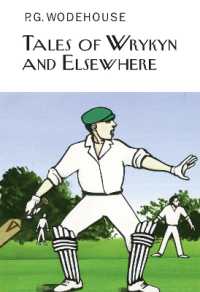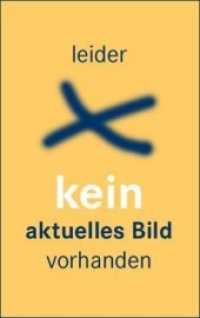- ホーム
- > 洋書
- > 英文書
- > Computer / General
Full Description
This is an introductory to intermediate level text on the science of image processing, which employs the Matlab programming language to illustrate some of the elementary, key concepts in modern image processing and pattern recognition. The approach taken is essentially practical and the book offers a framework within which the concepts can be understood by a series of well chosen examples, exercises and computer experiments, drawing on specific examples from within science, medicine and engineering. Clearly divided into eleven distinct chapters, the book begins with a fast-start introduction to image processing to enhance the accessibility of later topics. Subsequent chapters offer increasingly advanced discussion of topics involving more challenging concepts, with the final chapter looking at the application of automated image classification (with Matlab examples) .
Matlab is frequently used in the book as a tool for demonstrations, conducting experiments and for solving problems, as it is both ideally suited to this role and is widely available. Prior experience of Matlab is not required and those without access to Matlab can still benefit from the independent presentation of topics and numerous examples.
Features a companion website www.wiley.com/go/solomon/fundamentals containing a Matlab fast-start primer, further exercises, examples, instructor resources and accessibility to all files corresponding to the examples and exercises within the book itself.
Includes numerous examples, graded exercises and computer experiments to support both students and instructors alike.
Contents
Preface. Using the book website.
1 Representation.
1.1 What is an image?
1.1.1 Image layout.
1.1.2 Image colour.
1.2 Resolution and quantization.
1.2.1 Bit-plane splicing.
1.3 Image formats.
1.3.1 Image data types.
1.3.2 Image compression.
1.4 Colour spaces.
1.4.1 RGB.
1.4.2 Perceptual colour space.
1.5 Images in Matlab.
1.5.1 Reading, writing and querying images.
1.5.2 Basic display of images.
1.5.3 Accessing pixel values.
1.5.4 Converting image types.
Exercises.
2 Formation.
2.1 How is an image formed?
2.2 The mathematics of image formation.
2.2.1 Introduction.
2.2.2 Linear imaging systems.
2.2.3 Linear superposition integral.
2.2.4 The Dirac delta or impulse function.
2.2.5 The point-spread function.
2.2.6 Linear shift-invariant systems and the convolution integral.
2.2.7 Convolution: its importance and meaning.
2.2.8 Multiple convolution: N imaging elements in a linear shift-invariant system.
2.2.9 Digital convolution.
2.3 The engineering of image formation.
2.3.1 The camera.
2.3.2 The digitization process.
2.3.3 Noise.
Exercises.
3 Pixels.
3.1 What is a pixel?
3.2 Operations upon pixels.
3.2.1 Arithmetic operations on images.
3.2.1.2 Multiplication and division.
3.2.2 Logical operations on images.
3.2.3 Thresholding.
3.3 Point-based operations on images.
3.3.1 Logarithmic transform.
3.3.2 Exponential transform.
3.3.3 Power-law (gamma) transform.
3.4 Pixel distributions: histograms.
3.4.1 Histograms for threshold selection.
3.4.2 Adaptive thresholding.
3.4.3 Contrast stretching.
3.4.4 Histogram equalization.
3.4.5 Histogram matching.
3.4.6 Adaptive histogram equalization.
3.4.7 Histogram operations on colour images.
Exercises.
4 Enhancement.
4.1 Why perform enhancement?
4.2 Pixel neighbourhoods.
4.3 Filter kernels and the mechanics of linear filtering.
4.3.1 Nonlinear spatial filtering.
4.4 Filtering for noise removal.
4.4.1 Mean filtering.
4.4.2 Median filtering.
4.4.3 Rank filtering.
4.4.4 Gaussian filtering.
4.5 Filtering for edge detection.
4.5.1 Derivative filters for discontinuities.
4.5.2 First-order edge detection.
4.5.3 Second-order edge detection.
4.6 Edge enhancement.
4.6.1 Laplacian edge sharpening.
4.6.2 The unsharp mask filter.
Exercises.
5 Fourier transforms and frequency-domain processing.
5.1 Frequency space: a friendly introduction.
5.2 Frequency space: the fundamental idea.
5.2.1 The Fourier series.
5.3 Calculation of the Fourier spectrum.
5.4 5.4 Complex Fourier series.
5.5 The 1-D Fourier transform.
5.6 The inverse Fourier transform and reciprocity.
5.7 The 2-D Fourier transform.
5.8 Understanding the Fourier transform: frequency-space filtering.
5.9 Linear systems and Fourier transforms.
5.10 The convolution theorem.
5.11 The optical transfer function.
5.12 Digital Fourier transforms: the discrete fast Fourier transform.
5.13 Sampled data: the discrete Fourier transform.
5.14 The centred discrete Fourier transform.
6 Image restoration.
6.1 Imaging models.
6.2 Nature of the point-spread function and noise.
6.3 Restoration by the inverse Fourier filter.
6.4 The Wiener?Helstrom Filter.
6.5 Origin of the Wiener?Helstrom filter.
6.6 Acceptable solutions to the imaging equation.
6.7 Constrained deconvolution.
6.8 Estimating an unknown point-spread function or optical transfer function.
6.9 Blind deconvolution.
6.10 Iterative deconvolution and the Lucy?Richardson algorithm.
6.11 Matrix formulation of image restoration.
6.12 The standard least-squares solution.
6.13 Constrained least-squares restoration.
6.14 Stochastic input distributions and Bayesian estimators.
6.15 The generalized Gauss?Markov estimator.
7 Geometry.
7.1 The description of shape.
7.2 Shape-preserving transformations.
7.3 Shape transformation and homogeneous coordinates.
7.4 The general 2-D affine transformation.
7.5 Affine transformation in homogeneous coordinates .
7.6 The Procrustes transformation.
7.7 Procrustes alignment.
7.8 The projective transform.
7.9 Nonlinear transformations.
7.10Warping: the spatial transformation of an image.
7.11 Overdetermined spatial transformations.
7.12 The piecewise warp.
7.13 The piecewise affine warp.
7.14 Warping: forward and reverse mapping.
8 Morphological processing.
8.1 Introduction.
8.2 Binary images: foreground, background and connectedness.
8.3 Structuring elements and neighbourhoods.
8.4 Dilation and erosion.
8.5 Dilation, erosion and structuring elements within Matlab.
8.6 Structuring element decomposition and Matlab.
8.7 Effects and uses of erosion and dilation.
8.7.1 Application of erosion to particle sizing.
8.8 Morphological opening and closing.
8.8.1 The rolling-ball analogy.
8.9 Boundary extraction.
8.10 Extracting connected components.
8.11 Region filling.
8.12 The hit-or-miss transformation.
8.12.1 Generalization of hit-or-miss.
8.13 Relaxing constraints in hit-or-miss: ?don?t care? pixels.
8.13.1 Morphological thinning.
8.14 Skeletonization.
8.15 Opening by reconstruction.
8.16 Grey-scale erosion and dilation.
8.17 Grey-scale structuring elements: general case.
8.18 Grey-scale erosion and dilation with flat structuring elements.
8.19 Grey-scale opening and closing.
8.20 The top-hat transformation.
8.21 Summary.
Exercises.
9 Features.
9.1 Landmarks and shape vectors.
9.2 Single-parameter shape descriptors.
9.3 Signatures and the radial Fourier expansion.
9.4 Statistical moments as region descriptors.
9.5 Texture features based on statistical measures.
9.6 Principal component analysis.
9.7 Principal component analysis: an illustrative example.
9.8 Theory of principal component analysis: version 1.
9.9 Theory of principal component analysis: version 2.
9.10 Principal axes and principal components.
9.11 Summary of properties of principal component analysis.
9.12 Dimensionality reduction: the purpose of principal component analysis.
9.13 Principal components analysis on an ensemble of digital images.
9.14 Representation of out-of-sample examples using principal component analysis.
9.15 Key example: eigenfaces and the human face.
10 Image Segmentation.
10.1 Image segmentation.
10.2 Use of image properties and features in segmentation.
10.3 Intensity thresholding.
10.3.1 Problems with global thresholding.
10.4 Region growing and region splitting.
10.5 Split-and-merge algorithm.
10.6 The challenge of edge detection.
10.7 The Laplacian of Gaussian and difference of Gaussians filters.
10.8 The Canny edge detector.
10.9 Interest operators.
10.10 Watershed segmentation.
10.11 Segmentation functions.
10.12 Image segmentation with Markov random fields.
10.12.1 Parameter estimation.
10.12.2 Neighbourhood weighting parameter θn
10.12.3 Minimizing U(x|y): the iterated conditional modes algorithm.
11 Classification.
11.1 The purpose of automated classification.
11.2 Supervised and unsupervised classification.
11.3 Classification: a simple example.
11.4 Design of classification systems.
11.5 Simple classifiers: prototypes and minimum distance criteria.
11.6 Linear discriminant functions.
11.7 Linear discriminant functions in N dimensions.
11.8 Extension of the minimum distance classifier and the Mahalanobis distance.
11.9 Bayesian classification: definitions.
11.10 The Bayes decision rule.
11.11 The multivariate normal density.
11.12 Bayesian classifiers for multivariate normal distributions.
11.12.1 The Fisher linear discriminant.
11.12.2 Risk and cost functions.
11.13 Ensemble classifiers.
11.13.1 Combining weak classifiers: the AdaBoost method.
11.14 Unsupervised learning: k-means clustering.
Further reading.
Index.








